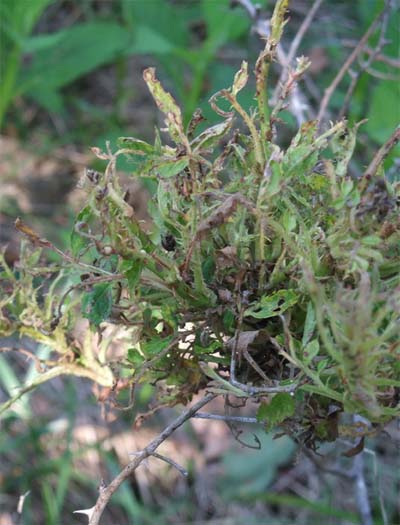Rose Rosette Disease
By Anna Benton, past Virginia Cooperative Extension Intern

Small branches on rose known as witches’ broom
There is no cure for this disease right now, and there are no resistant rose varieties. That means your Knock Out roses are at risk. In fact, large mass plantings of any rose variety are often targets for the disease.
Plants that have been diagnosed with rose rosette should be removed from the landscape immediately, roots and all, to prevent the spread of the disease. The diseased plants should be bagged and disposed in the trash.

Deformed flowers
Rose rosette disease was a fairly recent introduction to the United States in 1941. But the devastating spread of the disease did not start until the push for increased use of multiflora rose in all kinds of conservation efforts in the 1930s through 1960s. Those recommendations quickly stopped when it was discovered that multiflora rose was capable of out-competing a lot of other plants and becoming quite invasive. It just so happens that it was a double blow, as this now noxious weed is also extremely susceptible to the devastating disease rose rosette.
The widespread presence of multiflora rose in the United States ecosystems has allowed for speedy and extensive spread of the rose rosette disease. Even though multiflora rose is most susceptible, cultivated roses can also be decimated by rose rosette disease. The disease is spread by the microscopic eriophyid mite (Phyllocoptes fructiphilus). The mites transmit the virus that actually causes the disease. They do not fly, but they crawl, ride on passersby, and mostly are carried by the wind.

Increased thorning
Caution should be taken in planting cultivated roses down-wind from multiflora rose, as they will soon become infected. Because the causal agent, Rose rosette virus, has been identified, the disease can be definitively diagnosed early in the disease cycle instead of waiting until all of the characteristic symptoms are present. This, however, takes specific lab capabilities, and the test is not routinely offered by many labs. Therefore, it is still important to be able to identify the visual symptoms of rose rosette disease. As noted above, the initial visual symptoms include red, distorted, and stunted new leaf growth, an increase of shoot generation (witches’ brooming), increased thorning, and shortened internodes. Discoloration, increased numbers and distortion of flowers are also symptoms.
Be careful when using select symptoms to diagnose rose rosette. When all of the symptoms are present, a diagnosis is fairly certain, but individually, each symptom could be caused by something else. For example, new leaf growth on roses is often red; herbicide (glyphosate) damage causes distorted and stunted leaves and witches’ brooms, and growth regulators (2,4-D) cause increased shoot size.
So take care to prevent infection by removing the oft-infected multiflora roses. Don’t plant downwind from multiflora, provide ample spacing between newly planted roses, and practice good sanitation when pruning. Use of carbaryl spray to control the mites is possible, but it can cause severe outbreaks of other insect infestations.
References
• Rose Rosette Disease, Virginia Cooperative Extension
• Frequently Asked Questions About Rose Rosette Virus, Clemson Cooperative Extension
• Rose Rosette Disease: Demystified, Kevin Ong, Molly Giesbrecht, Dotty Woodson and Laura Miller,
Texas A&M Extension
… updated 2022